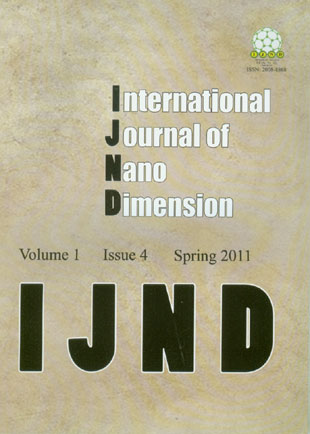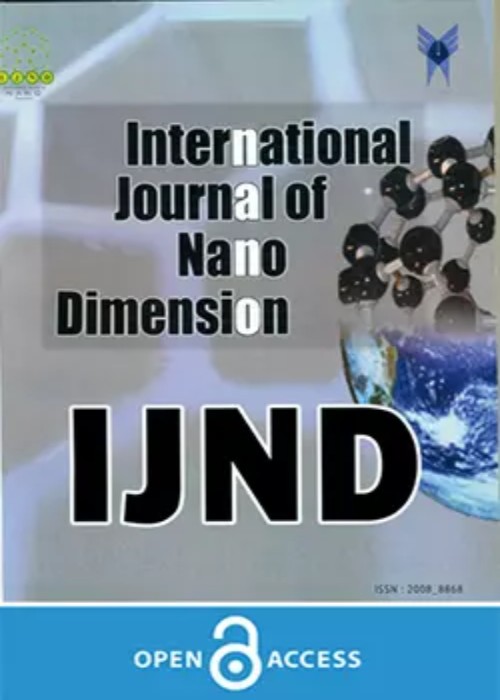فهرست مطالب

International Journal of Nano Dimension
Volume:1 Issue: 4, Spring 2011
- تاریخ انتشار: 1390/02/12
- تعداد عناوین: 8
-
Page 253While the application of optical and photonic technologies in the communications, computing, medicine and industrial manufacturing has been growing rapidly, the miniaturization of these technologies has been slow due to the limitation on the diffraction. However, the developments of nanoscale components and guiding methods are continuing with a rapid pace. Since waveguiding is a fundamental issue in communication, we briefly examine the current state of nanoscale waveguiding with their application in communication which are the building blocks of ultra-high density photonic devices. Finally, we conclude that the QD waveguide may be an effective and an alternative means to transmit light.
-
Page 257Density functional theory (DFT) calculations were performed to investigate the properties of planar, tubular and conical forms of silicon nanostructures. The evaluated parameters including averaged bond lengths, binding energies, gap energies and dipole moments were then evaluated for the optimized models of study. The results indicated that the bond lengths between silicon atoms are different in the three forms of structures.The binding energies indicated that the planar form could be considered as the most stable form of silicon nanostructures among the investigated forms. Better conductivity of the conical form than the tubular and planar forms was confirmed by the gap energies. The dipole moments indicated that the planar and tubular forms of silicon nanostructures are non-polar whereas the conical form is a polar silicon nanostructure.
-
Page 261In this study, selenium was recovered from an industrial dust. After the purification process, the researchers were able to prepare selenium micro powder. The objective of this study was to prepare selenium nano particles by water solution phase method from the micro powders. The results showed that selenium micronized powder and nano particles had high purity. The obtained nanoparticles were tube shaped with 20 nm size.
-
Page 269One of the best and the most active ways for surveying thermal behaviour of materials is using differential scanning calorimetry. In this paper, the authors have studied thermal behaviour for Schiff base ligand and their synthesized Cobalt, Nickel complexes. In this method, the sample is opposed to a controlled temperature change and its physical properties. Here we studied melting point and Tg and thermal destructive by surveying DSC thermograms of above compounds. Our team also have surveyed thermograms from the mix of these compounds with nano silver.
-
Page 275Gold nanoparticles were synthesized by chemical reduction of HAuCl4 inside the pores of a polycarbonate-based membrane followed by dissolving the membrane in dichloromethane and further sonication. Sonication time as the main affecting factor on the nanoparticle size was investigated. The characterization by transmission electron microscopy showed the formation of gold nanoparticles with diameters less than 20 nm and a uniform distribution of the nanoparticle size. This template method is particularly interesting, because it allows including metallic constituents inside the voids of nanoporous host materials resulting in monodisperse diameter nanomaterials.
-
Page 279The nanomaterials have important application in different field of science such as biology and pharmacology, which draws the attention of biologists towards this field of study more than before. As the world wide mortality rate is high due to the pathogens and especially because of the bacteria associated dysenteriae and the antibacterial effect of metal nanoparticles is well known from centuries- these materials can be used to annihilate Shigella dysenteriae. Here, we study the antibacterial characteristics of metal nanoparticle; ZnO against Shigella dysenteriae (type 1). Firstly, solid state pyrolytic reaction process has been used to synthesize ZnO nanoparticles. The characteristics were investigated by XRD, SEM and UV-Visible spectrometer. The optical density (OD) of S.dysenteriae was observed in the presence of 0.05% ZnO. This study showed that the presence concentration of nanoparticle was insufficient to the demonstrated antibacterial activity. But a considerable decrease in the bacterial number was observed in the presence of 0.5% and 1% ZnO nanoparticles. A 1.7 times decrease in the OD of S.dysenteriae was recorded of control group (p<0.001). The recorded in OD was 2.2 and 3.1 times in the presence of 0.5 and 1% ZnO nanoparticles respectively (p<0.05). Thus, ZnO nanoparticle can be potential?) candidate of antibacterial agent.
-
Page 287In this study, we investigated the antifungal effects of silver nanoparticles (Ag-Nps) on Candida albicans (ATCC 5027), Saccharomyces cerevisiae (ATCC 5027). Investigating method by using Minimum Inhibitory Concentration (MIC) technique, some of drugs including Amphotericin B, Fluconazole and synthesized Ag-Nps have been obtained on the fungi and the changes on membrane reactions of yeasts have been elucidated by Scanning Electron Microscopy (SEM). The present study indicates Ag-Nps has considerable antifungal activity comparison with other antifungal drugs, so deserving further investigation for clinical applications.
-
Page 297The present work is an experimental study of steady state convective heat transfer of de-ionized water with a (0.04% by volume) volume fraction of Al2O3 nanoparticles dispersed to form a nanofluid that flows through an aluminium tube.Laminar fully developed flow heat transfer coefficient of Al2O3 nanoparticles are dispersed in water in circular tube is discussed in this paper. In order to validate the heat transfer coefficient of nanofluid in circular tube commercially available CFD software FLUENT 6.3.26 is used. The thermo-physical properties of the Al2O3nanofluid are estimated by using the equations available inliterature. Thermo-physical properties of the nanofluid are considered for heat transfer coefficient by assuming nanofluid is a single-phase fluid. Constant Wall Heat Flux (CWHF) boundary condition is incorporated for heat transfer analysis. The flow and temperature fields are assumed fully developed (x/D>10). The analysis is conducted in the volumeconcentration from 0.4%.A maximum of 2.25 times heat transfer enhancement is obtained by using nanofluid as working medium.


